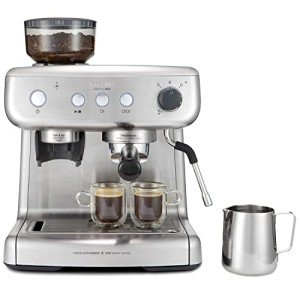The Art of Italian Espresso Machines: A Brewed Tradition
Italian espresso machines are not just devices; they are an important part of Italy's abundant coffee culture, representing a mix of artistry, engineering, and style. Coffee connoisseurs worldwide acknowledge the importance of high-quality espresso, a staple of Italian life and food. This article explores the history, mechanics, types, and factors to consider when purchasing an Italian espresso machine, showing the depth of this beloved drink and its brewing techniques.
History of Espresso Machines
The espresso machine's advancement go back to the early 20th century in Italy, where coffee was not merely a drink but an essential social ritual. The preliminary attempts to brew espresso started with simple, stove-top designs, gradually evolving into complicated machines that might reproduce the best brew.
- 1901-- The First Espresso Machine: The very first steam-powered espresso machine, known as the "Ideale," was developed by Luigi Bezzera. This equipment marked a turning point in espresso brewing.
- 1938-- The Lever Machine: The intro of the lever machine made it simpler to control the pressure utilized in espresso extraction, enhancing taste consistency.
- 1947-- The Automatic Machine: Reaching more consumers, Gaggia introduced the very first automatic espresso machine, further popularizing espresso bars.
- 2007-- The Digital Age: Technological developments led to the birth of fully programmable machines, permitting users to tailor their developing settings to attain a personalized coffee experience.
Secret Features of Italian Espresso Machines
Italian espresso machines embody precision, craftsmanship, and development. Here are some essential parts that highlight their significance:
| Feature | Description |
|---|---|
| Boiler Type | Determines how heat is created and maintained. Common types consist of single boiler, dual boiler, and heat exchanger. |
| Group Heads | Where the coffee is brewed; commercial machines typically have multiple group heads for performance. |
| Pressure Control | Essential for accomplishing the best espresso; most machines operate at 9 bars of pressure. |
| Frothing Capabilities | The steam wand permits milk frothing, important for beverages like cappuccino and latte. |
| Build Quality | The materials used (stainless steel, brass, etc) impact toughness and heat retention. |
Kinds Of Italian Espresso Machines
Picking the right machine depends upon user preferences, budget, and meant use. Below are the primary types of Italian espresso machines:
Manual Espresso Machines
- Pros: Offer complete control over the brewing procedure, permitting an individualized touch.
- Cons: Require ability and practice, can be labor-intensive.
Semi-Automatic Machines
- Pros: Provide a balance between automated and manual processes; users manage water flow.
- Cons: Can have a steeper learning curve than completely automatic machines.
Completely Automatic Machines
- Pros: Simplify the developing procedure with push-button operations; suitable for beginners.
- Cons: May sacrifice some of the nuances of manual developing.
Super-Automatic Machines
- Pros: Grind, tamp, brew, and froth immediately; hassle-free for hectic way of lives.
- Cons: Less control over the developing variables, potential for a less authentic espresso experience.
Buying Guide: Factors to Consider
Selecting the perfect Italian espresso machine can be challenging, however thinking about the following factors can streamline the decision-making procedure:
- Budget: Italian espresso machines vary from affordable to high-end designs, so set a budget upfront.
- Usage Frequency: Evaluate how frequently you will use the machine; daily users may want a more long lasting choice.
- Space: Measure your kitchen area or counter area; some machines can be large and require sufficient clearance.
- Maintenance: Consider ease of cleansing; machines with removable parts or integrated cleaning features may reduce upkeep.
- User Skill Level: Beginners might prefer fully or semi-automatic machines, while experienced baristas can handle manual machines.
- Brand Reputation: Research brand names understood for quality, such as Breville, Gaggia, and La Marzocco.
Popular Italian Espresso Machine Brands
Italian workmanship is renowned for producing a few of the very best espresso machines worldwide. Here are top brands worth thinking about:
- Gaggia: Known for its home espresso machines and cost.
- La Marzocco: A premium brand known for its commercial-grade machines and innovative technology.
- Rancilio: Renowned for its durable construct and professional-quality machines ideal for home and commercial use.
- Sage/Breville: Offers advanced features and easy to use styles, ideal for both beginners and enthusiasts.
Frequently asked questions
What is the distinction between espresso and routine coffee?
Espresso is a focused coffee brewed by forcing hot water through finely-ground coffee under pressure. It has a thicker consistency, richer taste, and greater caffeine concentration than routine coffee.
Can I make milk-based drinks with an espresso machine?
Yes, lots of Italian espresso machines come with a steam wand to froth milk for drinks like coffees, lattes, and macchiatos.
How typically should I clean my espresso machine?
Routine upkeep is necessary. Normally, an extensive cleansing is recommended every couple of weeks, while descaling needs to be done every 1 to 3 months, depending upon water hardness.
What is the ideal pressure for brewing espresso?
The ideal pressure for brewing espresso is around 9 bars. Steam Espresso Machines ensures the ideal extraction of tastes from the coffee grounds.
Are more expensive machines worth the investment?
Higher-end machines typically utilize better products and technology, providing enhanced resilience and more constant results. For major coffee lovers, investing in a great machine can raise the espresso experience substantially.
Italian espresso machines are far more than mere brewing gadgets; they are an event of a cultural tradition that has affected coffee usage worldwide. With Latte Machines offered to fit any user's needs-- ranging from novices to skilled baristas-- there is an Italian espresso machine completely suited for everyone. As you start your espresso journey, understanding the history, mechanics, and options will improve your experience and gratitude for this time-honored beverage. Whether you look for to recreate a coffee shop ambiance in your home or refine your brewing strategy, these machines can delivering unforgettable cups of espresso decorated with the abundant history of Italian coffee culture.

